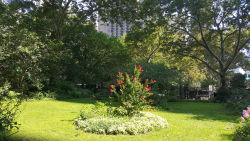St. Vartan Park
St. Vartan Park
St. Vartan Park, between East 35th and 36th Streets on Second Avenue, is named for the St. Vartan Cathedral of the Armenian Orthodox Church in America. Vartan was an Armenian who lived during the fourth century, remembered for his martyrdom at the Battle of Avarayr in 451AD between Armenian and Iranian forces in present-day Albania.
In June 1897, Mayor William L. Strong (1827–1900) appointed an advisory committee that became known as the Small Parks Commission. That commission selected this site for a park in 1901, and they acquired the land through condemnation two years later. This park opened as St. Gabriel’s Park in 1904, named for nearby St. Gabriel Church formerly at 310 East 37th Street. The park was reconstructed in 1936, and a playground, wading pool, roller skating track, and courts for handball, shuffleboard, and horseshoe pitching were added, as well as a field house and public restroom.
In 1938, shortly after the park was renovated, part of the land was surrendered to the Board of Estimate. This was part of an agreement with the New York City Tunnel Authority to make way for an approach to the Queens-Midtown Tunnel completed in 1940. The park’s trees, benches, and playground areas were relocated as the approach road cut the park in two, and decreased the parkland by nearly a quarter acre. In exchange, the Tunnel Authority agreed to improve nearby parks and playgrounds in the vicinity of 42nd Street.
By 1951, residents of the congested neighborhood had succeeded in restoring the playground areas lost when the tunnel approach was built. The renovation added a sand pit, jungle gym, and seesaws as well as a 16-foot-high fence separating the ball field and the children’s playground. In 1978 the property was renamed St. Vartan Park.
A 1984 renovation remodeled the park’s 1936 field house and playground. The building serves as a program center for preschoolers, teens, and seniors. The renovation added safety surfacing, benches, water fountains, game tables, a sprinkler, a small concrete amphitheater, and timberform play equipment. More than 9,200 shrubs were planted, including Japanese barberry, firethorn, baltic ivy, rhododendron, and forsythia. Saucer magnolia and honey locust trees were also planted at the site.
The 1984 renovation was privately funded, a harbinger of a new era of creative financing to aid the City’s park system, which suffered in the wake of the City's 1970s fiscal crisis. The Glick Organization contributed $900,000 to enhance the site. “This is my favorite kind of dedication,” Mayor Edward I. Koch noted at the park’s reopening, “one where a city park has been rebuilt without a penny of city money.”
In 2000 Council Member Andrew S. Eristoff allocated $250,000 for a new playground, and his successor, Council Member Eva S. Moskowitz provided an additional $332,000 for the renovation. Designed by Parks' Bernadette Grullon and completed in 2002, the project included the installation of new pavements, curbs, fences, benches, play equipment with safety surfacing, and a new water supply, drinking fountain, and drainage system. Ms. Grullon added a spray shower in the center of the amphitheater, and an animal art sculpture near the park’s northern entrance.
Check out your park's Vital Signs
Clean & Safe
Green & Resilient
Empowered & Engaged Users
Share your feedback or learn more about how this park is part of a
Vital Park System










